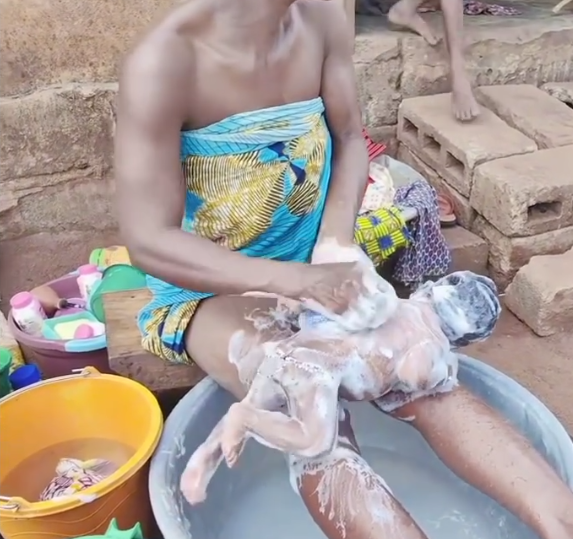The baby let out a soft, muffled cry as the cold water struck its delicate skin. It was barely a few months old—its fragile body limp, its limbs thin, and its cries barely louder than a whisper. But what happened next left millions across the internet gasping in horror, hearts aching with disbelief.
In a small rural village nestled deep within Africa, far away from paved roads, hospitals, or modern child-rearing practices, a mother performed what she believed was a sacred duty—a ritual passed down from generations. In her eyes, it was not only tradition, it was love. But to the outside world, watching through the lens of a viral video, it looked like an act of unimaginable risk.
With one hand, she held the baby by the neck and back. With the other, she scooped water and poured it over the child’s head. The baby squirmed, clearly distressed. But she didn’t stop. The mother dipped the baby’s entire body into the bucket, flipping the infant with swift movements that seemed rehearsed. It wasn’t a bath. It was a vigorous cleanse—aggressive, unrelenting, and terrifying to watch.
People watching the video cried out in comments:
“What is she doing?!”
“She’s going to hurt the baby!”
“This should be illegal!”
And then came the flood of sympathy:
“That poor baby 😢”
“Someone help!”
The footage quickly spread like wildfire across social media platforms. It was shared by shocked parents, pediatricians, and influencers alike. “How could any mother do this to her own child?” many questioned. The emotional responses were overwhelming. But beneath the surface of the outrage, lay something even deeper: a cultural misunderstanding wrapped in centuries of tradition, survival, and belief.
A Ritual Born From Tradition
In this village, and many others like it across parts of rural Africa, such “baby baths” aren’t considered dangerous—they are considered essential. The belief is that these forceful washes make the baby stronger, more resistant to illness, and used to harsh conditions from an early age. To them, it’s not cruelty—it’s preparation. Preparation for a hard life in an unforgiving world.
To the Western eye, these methods seem brutal and heartless. But for generations, mothers here have trusted their elders, and their elders before them. These methods were not only ritual—they were protection. In regions where access to modern medicine is limited, traditions become the only form of healthcare.
But tradition doesn’t always mean safety. What once may have served a purpose—when access to water was rare and diseases were rampant—can now become a risk when better knowledge exists. The baby in the video was visibly stressed. The temperature of the water was not monitored. The speed and force of the bath could lead to hypothermia, head trauma, or even drowning if misjudged.
And yet, the mother didn’t see this. She wasn’t being abusive. She wasn’t being careless. She was doing what she believed was right—what her mother did to her, and what her grandmother had done before that.
The Global Divide
In a world connected by internet, but divided by culture, what one mother considers nurturing, another may see as neglect. A mother in New York would cradle her baby in a warm bath, gently rinsing with a soft sponge, ensuring the temperature is just right. A mother in this African village might believe a firm rub and a cold splash is what strengthens a child’s immune system and spirit.
Social media brings visibility. But it often brings judgment without context. This video—though jarring—opened up a much-needed conversation. Pediatricians from around the world began to chime in. Nonprofit organizations working in maternal education took interest. Some argued for compassion and education, not condemnation.
Because the truth is—this isn’t just one mother. This is a practice still common in many developing regions. And unless there is outreach, education, and support—these practices will continue.
The Cost of Survival
What many don’t see in the video is the life behind the lens. That village lacks clean water. There are no hospitals within walking distance. If a child gets a fever, it can be fatal. That mother likely wakes up at 4AM to fetch water from a distant well, cook over firewood, and tend to multiple children—sometimes without the support of the baby’s father.
In this world, parenting is a matter of survival.
Every splash of cold water, every forceful rub, is a cry to the universe:
“Please let my baby be strong enough to live.”
But as noble as her intentions may be, the risks are real. Pediatric trauma, lung aspiration, hypothermia, and developmental issues are all possible when a newborn is treated too harshly during bathing. That baby’s soft skull and underdeveloped lungs cannot handle such force. And while she may have been bathed like this and survived—it doesn’t mean it’s safe.
A Call for Compassion, Not Just Criticism
The outrage is understandable. Anyone who loves children will feel the ache watching such a clip. But the solution isn’t to shame. It’s to educate. The mother doesn’t need punishment—she needs access. Access to knowledge. To clinics. To parenting support groups.
Organizations around the world are stepping in. Campaigns that provide “baby care kits” now include not just diapers and clothes, but pictorial guides showing how to bathe an infant safely. NGOs are working with local midwives to teach gentle bathing and postnatal care. And slowly, change is coming.
But it starts with empathy.
Imagine for a moment that your only guide to parenting was what your mother taught you—without books, doctors, or YouTube. Imagine believing that unless your baby is washed like this, it will grow up weak, sickly, or die young. That fear becomes your reality. You don’t question it. You just obey.
Now imagine being told—by strangers across the world—that you’re a bad mother.
Wouldn’t you feel lost? Confused? Hurt?
That’s why this video, heartbreaking as it is, must be a spark—not for judgment—but for global understanding and action.
The Baby’s Fate
As for the baby—sources say the child is alive and healthy. But that doesn’t erase the danger it was in. Each time this ritual is repeated, there is a chance—no matter how small—that something could go terribly wrong. And that’s what makes education urgent.
Viewers who saw the video continue to ask:
“Why hasn’t anyone stepped in?”
“Where are the child protection services?”
The hard truth? In many remote regions, such services don’t exist. And until they do, it is up to the global community to raise awareness. To send help. To share information, not hate.
What Can Be Done?
-
Support Organizations working in maternal and child health across Africa and other regions.
-
Share educational videos on gentle infant care translated into local languages.
-
Avoid public shaming—choose to explain rather than condemn.
-
Understand before judging—traditions don’t change overnight, but they do change with consistent outreach.
Final Words
The image of that baby—eyes closed, mouth open in a soundless cry—will haunt many. The hands that held it were not cruel, but misguided. This was not a monster hurting a child. This was a mother trying her best with what she knew.
Let us not forget that behind every viral moment is a real life. A real baby. A real mother.
And sometimes, the greatest danger isn’t the act itself—but the silence that follows it.
Let’s speak—but let’s speak wisely. Let’s act—but let’s act compassionately.
Because that’s how real change begins.

